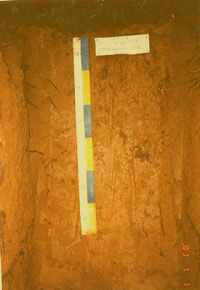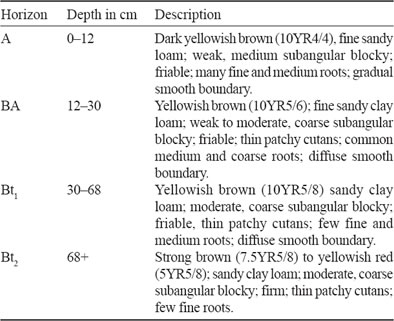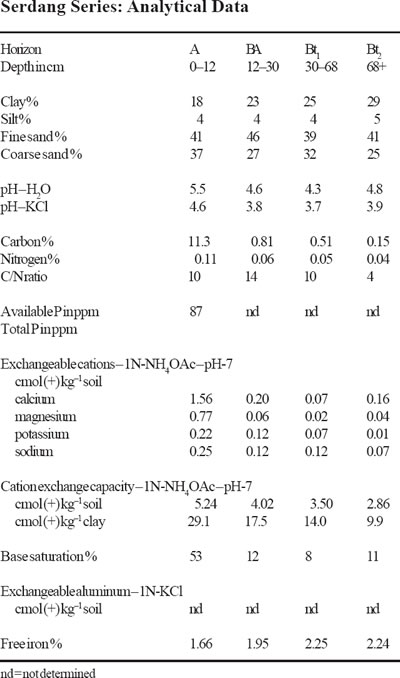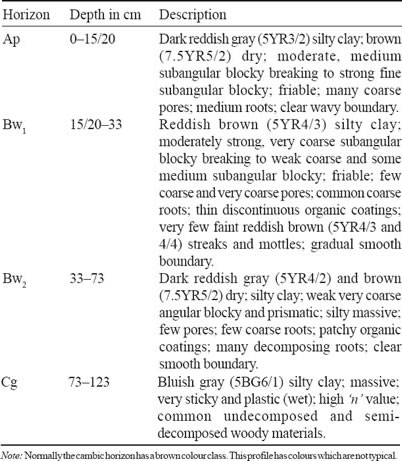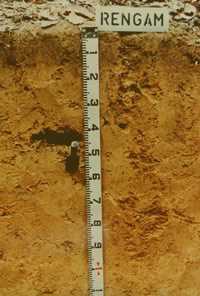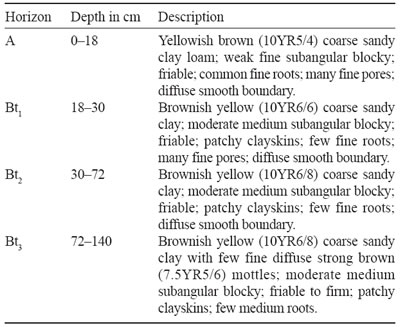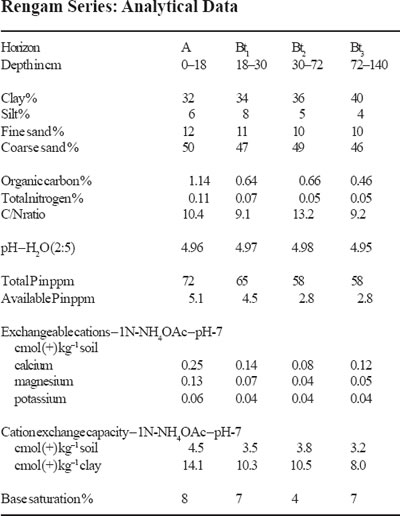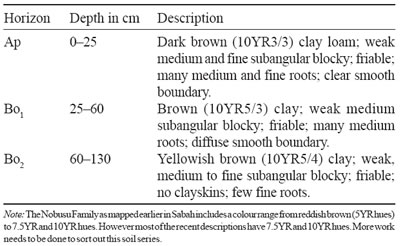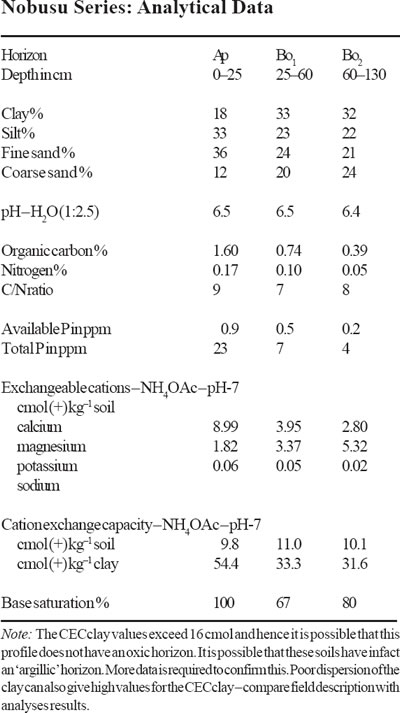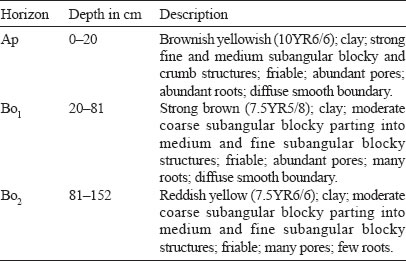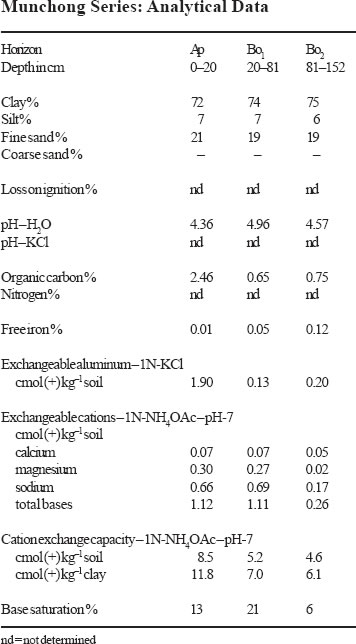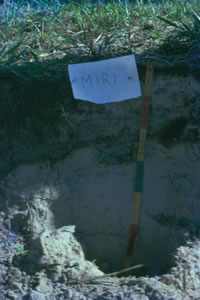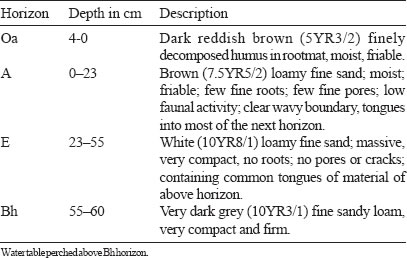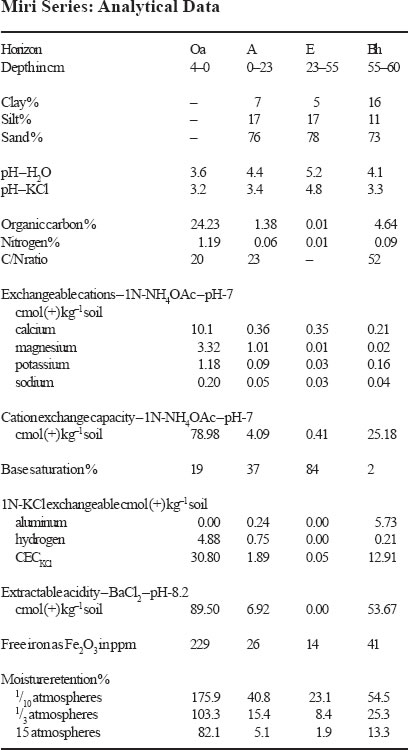Soil Profiles: Ulu Dong
Ulu Dong Series
The Ulu Dong Series is a member of the family of very fine, kaolinitic, isohyperthermic, red Tipik Lutualemkuts. It is developed over quartz-mica-schists. They are characterized here by their deep kandic horizons with a clay content of more than 60% with no significant decrease to 100 cm of the soil surface and their red to yellowish red colours. Structures are weak medium and coarse subangular blocky and consistence is friable. Patchy clayskins occur on ped faces. The CECclay is less than 16 cmol (+) in all horizons between 25 to 100 cm of the soil surface.
Type Location
The Ulu Dong Series were first described and studied by Lim (1977) near Dong village to the east of Raub. The above pedon was also described by Lim during the Detailed Reconnaissance Soil Survey of the KESEDAR Region, Ulu Kelantan (Lim et al. 1980) at the 57 km (36 milestone) Tanah Merah to Batu Melintang Road over quartz-mica-schists at an elevation of 103 m (340 feet) under secondary forest on hilly terrain. Location: Topographic Sheet 3867, 5°49′ N, 102°00′ E (Grid Reference 3867 – 440430 m).
Range in Characteristics
Little is known about the range in characteristics of the Ulu Dong Series. The main characteristics are that these soils must be deep and have a clay content of over 60% and the clay content should not decrease from the maximum by more than 20% within 100 cm of the soil surface. Some soils with about 55% clay have also been mapped as Ulu Dong Series in the past. Colours in the subsoils belong to the red colour class. Subsoil colours range from yellowish red (5YR4/6, 5/6, 5/8) to red (2.5YR3/6, 4/6, 4/8, 5/6, 5/8, 6/6, 6/8) to light red (2.5YR7/6, 7/8). The colours normally become redder with depth. Structures are weak coarse and medium subangular blocky and consistence is friable. Clayskins occur on ped faces. Mottling is rare and if present is faint.
Competing Soils and Their Differences
Soils of the Ulu Dong Series are likely to be confused with other red-coloured soils which have heavy clay (> 60% clay) textures. These include soils of the Patang, Prang, Kampong Kolam, Apas, Tarat and Sagu Series. All these soils have an oxic horizon while the Ulu Dong Series has a kandic horizon. The Langkawi Series over limestone has many properties similar to the Ulu Dong Series. The Ulu Dong Series generally has lower clay contents and some sand while the Langkawi Series higher clay content and virtually no sand. In Sabah no red-coloured soils with a deep kandic horizon have been mapped but some soils mapped as the Kumansi Series/deep/red variant may have some features similar to the Ulu Dong Series but the Kumansi Series normally have a CECclay of more than 24 cmol (+) kg–1 clay. Soils of the Chat Series (CECclay less than 16 cmol, red-yellow colour class), Melugu (CECclay 16–24 cmol, red-yellow colour class) and Stass (CECclay more than 24 cmol, red-yellow colour class) are similar textured but differ in CECclay values and subsoil colours. The Jakar Series has red colours but has 35–60% clay and a CECclay of more than 24 cmol.
Setting
Soils of the Ulu Dong Series to-date have been mapped on rolling, hilly to steep terrain (slopes in excess of 12% or 6°) at elevations of 30 m to over 200 m (100– 700 feet).
Principal Associated Soils
The Ulu Dong Series has been mapped in association with soils of the Chat Series (CECclay less than 16 cmol, red-yellow colour, clay content more than 60%). Occasionally they have also been mapped in association with soils of the Bungor Series (CECclay less than 16 cmol, clay content 35 to 60%, red-yellow colour class).
Drainage and Permeability <
Soils of the Ulu Dong Series are deep, well drained soils with a good permeability.
Use and Vegetation
Rubber, fruit trees and oil palm are the commonest crops grown on soils of the Ulu Dong Series. Some of these soils may still be under primary forest.
Distribution and Extent
Soils of the Ulu Dong Series have to-date been only mapped in the states of Kelantan, Pahang and Johor. Their actual extent is not fully known.
Series Established
The series was established by Lim (1977) during soil surveys in Pahang State. The source of name is the Kampong Ulu Dong off the Raub-Benta road, Pahang State, Peninsular Malaysia.
Remarks on Classification
Soils of the Ulu Dong Series are classified here according to the Malaysian Soil Taxonomy – Second Approximation (Paramananthan 1998) as a member of the very fine, kaolinitic, isohyperthermic red family of Tipik Lutualemkuts. They are classified as deep, well drained soils having a kandic horizon with red colours and a clay content in excess of 60%. In the Keys to Soil Taxonomy – Eighth Edition (Soil Survey Staff 1998) soils of the Ulu Dong Series are probably classified as Typic Kandiudox. In the FAO/UNESCO Soil Map of the World – Revised Legend (FAO 1990) these soils would probably be Haplic Nitisols.
Suitability for Agriculture
Soils of the Ulu Dong Series are probably suitable for a wide range of crops with proper management. The slope on which these soils occur, their low fertility status and phosphorus fixation are the main limitations. With good management these soils should be suitable for a wide range of crops such as oil palm, rubber, fruit trees, pepper and cocoa.
Soil Profiles: Table
Table Series
The Table Series is a member of the Table Family which is very fine, oxidic, isohyperthermic, brown Tipik Tempalemoks. It typifies this family and is developed over basalts (basic igneous rocks). Soils of the Table Series are characterized by their deep heavy clay textured oxic horizons with dark yellowish brown colours and an ECEC that is more than 1.5 cmol (+) kg–1 clay in all horizons between 25 to 100 cm depth. Structures are weak, medium to fine subangular blocky and consistence is friable.
Type Location
Soils of the Table Series were first established by Paton (1963) during the Reconnaissance Soil Survey of the Semporna Peninsula. The above pedon was described by staff of the Department of Agriculture, Sabah in the Quoin Hill Agriculture Station near Tawau, Sabah on undulating terrain (4–12% or 2–6° slopes) at an elevation of 200 m (600 feet) under oil palm. Location: Topographic Sheet 4/118/9, 4°03’35” N, 118°01’30” E (Grid Reference 4/118/9 – 915845 m).
Range in Characteristics
Little is known about the range in characteristics of this soil. The colours range from dark yellowish brown (10YR4/4, 4/6, 3/4, 3/6) to dark brown (7.5YR3/2, 3/3, 3/4) and brown (10YR4/3, 4/6 and 7.5YR4/3, 5/3 and 4/4, 5/4). Textures are uniformly heavy clays. These soils are deep and somewhat excessively drained. Structures are weak to moderate medium and fine subangular blocky and consistence is friable. Little is known about the range in chemical characteristics but as noted earlier the permanent charge values range from around 1.0–5 cmol (+) kg–1 clay.
Competing Soils and Their Differences
The typical brown colours of the Table Series is not likely to be confused with many other soils. Soils of the Kuantan Series have many characteristics similar to those of the Table Series and only the permanent charge values separates these two soil types. Soils of the Ambun Series are yellowish red to dark reddish brown in colour (hues of 5YR or 2.5YR) and are developed over ultrabasic rocks on steep slopes. Soils of the Katai Family over alluvium from basic and ultrabasic rocks ranges in colour from reddish brown to yellowish brown but have an argillic horizon. Soils of the Besar Series also have similar colours but have an argillic horizon with high base saturation values. Soils of the Tangga Series and the Sagu Series may also have similar colours but are developed over limestone parent material. The Nobusu Series has similar colours and chemical characteristics but has lower clay contents (35–60%) and is developed on alluvia from basic/ultrabasic rocks.
Setting
Soils of the Table Series typically occur on undulating to rolling terrain (4–24% or 2–12° slopes) at elevations of less than 200 m (< 600 feet).
Principal Associated Soils
Soils of the Table Series have to-date been only mapped in the Tawau-Semporna area in Sabah in association with the Apas Series and the Katai Series. The Apas Series is red in colour while the Katai occurs over alluvia and on undulating to level terrain and has an argillic horizon. As mentioned earlier those with a cation retention capacity of less than 1.5 cmol (+) kg–1 clay should be reclassified as the Kuantan Series.
Drainage and Permeability
Soils of the Table Series are generally well to somewhat excessively drained. Permeability is also generally good.
Use and Vegetation
In the Tawau area in Sabah where these soils have been mapped they have been mainly under oil palm, or logged primary forest. On the Quoin Hill Station where these soils occur other research plots with other cash crops and cocoa were also present.
Distribution and Extent
The Table Series has to-date been only mapped in the Tawau area in Sabah around Quoin Hill. The actual extent of these soils is not known.
Series Established
This soil was established by Paton (1963) during the Reconnaissance Soil Survey of the Semporna Peninsula. The source of name is not known.
Remarks on Classification
The Table Series is classified here according to the Malaysian Soil Taxonomy – Second Approximation (Paramananthan 1998) as a member of the very fine, oxidic, isohyperthermic brown family of Tipik Tempalemoks over basalt parent material. They are classified here as deep soils that have clayey brown coloured oxic horizon in which the permanent charge is more than 1.5 cmol (+) kg–1 clay. In the Keys to Soil Taxonomy – Eighth Edition (Soil Survey Staff 1998) these soils would probably be classified as Typic Hapludox. In the FAO/ UNESCO Soil Map of the World – Revised Legend (FAO 1990) the Table Series would probably be classified as Haplic Ferralsols.
Suitability for Agriculture
The main limitation for agriculture in these soils is their generally low fertility status, high P fixation, and their high permeability. They should be suitable for a wide range of crops.
Soil Profiles: Serdang
Serdang Series
The Serdang Series is a member of the family of fine loamy, siliceous, isohyperthermic, red-yellow Tipik Lutualemkuts. The Serdang Series is developed over mixed sedimentary rocks. They are developed on quartzite, sandstone or conglomerate parent material and are characterized by deep profiles having sandy loam to sandy clay loam textures. They range in colour from yellowish brown to strong brown. Structures are weak subangular blocky and consistence friable. These soils have a kandic horizon (CECclay < 16 cmol (+) kg–1 clay) which is weakly expressed but clay content increases gradually with depth. The CECclay is less than 16 cmol in all subhorizons between 25 to 100 cm depth. No significant clay decrease to 100 cm depth is allowed.
Type Location
The Serdang Series was first established during the survey of the Federal Experimental Station in Serdang by Panton (1954), near Kuala Lumpur. The above pedon was described by Vercruysse (1984) during the Semi-Detailed Soil Survey of the Gual-Periok area, Kelantan on the lower slopes of a low hill at an elevation of 20 m under rubber. Location: Topographic Sheet 3868, 6°01’35” N, 102°01’45” E (Grid Reference 3868 – 480667 m).
Range in Characteristics
Soils of the Serdang Series in spite of its widespread occurrence show fairly consistent morphological properties. The textures range from fine sandy loam, sandy loam, to fine sandy clay loams, in the surface horizon to fine sandy clay loam in the subsoil. The texture often becomes heavier (sandy clay) at depths around 100 cm. Fine sand dominates the sand fraction. Clay contents range from about 18% to about 35% within 50 cm of the surface. Only rarely do heavier textures occur. Colours are uniformly yellowish brown to brownish yellow (10YR5/6, 5/8, 6/6, 6/8). With depths the colours may be strong brown, reddish yellow (7.5YR5/6, 5/8, 6/6, 6/8, 7/6, 7/8; 5YR6/6, 6/8, 7/6, 7/8). The redder colours are more common on the steeper slopes. A red variant with red colours (10R4/6, 4/8, 5/6, 5/8; 2.5YR4/6, 4/8, 5/6, 5/8) has been mapped near Paloh in Johore but this is now included with the Laka Series. Structures are weak to moderate, medium and fine subangular to angular blocky and consistence friable even to over a metre depth. Occasionally a thin vein quartz band may be present but petroplinthite nodules are rare as a rule. These soils have thin patchy clayskins to depths over one metre. The soils are more than one metre deep. On the steeper slopes it grades into the shallower soils of the Nami and Kekura Series. On the footslopes these soils may have a few diffuse mottles at depth. As defined here soils of the Serdang Series must have a CECclay of less than 16 cmol (+) kg–1 clay in all subhorizons between 25 to 100 cm depth.
Competing Soils and Their Differences
Soils of the Serdang Series are not likely to be confused with many other soils. The Kekura and Kedah Series have similar features but the soil depth is less than 50 cm. The Nami and Keledang Series are also similar textured but soil depth ranges from between 50 to 100 cm. The Bungor Series is heavier textured, slightly stronger coloured and has relatively firmer consistence. Mottling is also invariably present in the Bungor Series. The Kemahang Series has all the features of the Serdang Series but the textures are coarse sandy clay loams. Soils of the Serdang Series can be confused with soils of the Bekenu Series (CECclay 16–24 cmol) and the Tanjong Lipat Series (CECclay > 24 cmol) mapped in Sarawak and Sabah but can be separated using the CEC values. Soils of the Serdang Series may be sometimes confused with terrace alluvial soils such as the Holyrood and Rasau Series. These soils occur level to gently undulating on river terraces. The Holyrood has coarse sandy clay loam. While the Rasau fine sandy clay loam textures. Soils of the Tukau Series in Sarawak are also developed on terraces. These soils on terraces get paler with depth and often rounded-pebbles are encountered. Soils of the Serdang Series are not likely to be confused with many other soils. The Kekura and Kedah Series have similar features but the soil depth is less than 50 cm. The Nami and Keledang Series are also similar textured but soil depth ranges from between 50 to 100 cm. The Bungor Series is heavier textured, slightly stronger coloured and has relatively firmer consistence. Mottling is also invariably present in the Bungor Series. The Kemahang Series has all the features of the Serdang Series but the textures are coarse sandy clay loams. Soils of the Serdang Series can be confused with soils of the Bekenu Series (CECclay
Setting
The Serdang Series soils occur on undulating to hilly terrain on quartzite, sandstone and conglomerate parent material. They may occupy the gentler slopes of steep ridges with the Kekura and Nami Series occurring on the steep ridge tops.
Principal Associated Soils
Soils of the Serdang Series have been often associated with soils of the Bungor, Munchong and with the Nami and Kekura Series. The Munchong Series is clayey textured, stronger structured and has an oxic horizon. The Bungor Series also has heavier textures with fine sand dominating. Consistence is also firmer and has reddish mottles at depth. The Nami and Kekura Series are shallower soils in which the parent material is encountered at depths within 100 and 50 cm respectively. As redefined here soils of the Serdang Series may be associated with soils of the Bekenu and Tanjong Lipat Series.
Drainage and Permeability
The Serdang Series is a well drained soil to over 100 cm depth. It has good permeability.
Use and Vegetation
A large variety of crops are grown on these soils. These include crops such as oil palm, rubber, fruit trees etc. Many areas with such soils are still under primary forest.
Distribution and Extent
To-date, except for the State of Perlis, these soils have been mapped in every state in Peninsular Malaysia. They have mainly been mapped in association with other soils and consequently their actual extent is not known. These as defined here may also be present in Sabah and Sarawak.
Series Established
This soil was established during the survey of the Federal Experimental Station in Serdang (Panton 1954). The source of name is Serdang Village near Kuala Lumpur.
Remarks on Classification
Soils of the Serdang Series are classified according to the Malaysian Soil Taxonomy – Second Approximation (Paramananthan 1998) as a member of the fine loamy, siliceous, isohyperthermic, red-yellow family of Tipik Lutualemkuts. They are classified as soils having a deep kandic horizon with between 18 and 35% clay content. In the Keys to Soil Taxonomy – Eighth Edition (Soil Survey Staff 1998), soils of the Serdang Series would probably be Typic Kandiudults. In the FAO/ UNESCO Soil Map of the World – Revised Legend (FAO 1990) the Serdang Series would be classified as Haplic Nitisols.
Suitability for Agriculture
The deep, friable soils of the Serdang Series appear to be well suited for a wide range of crops. However these soils on account of their loamy texture and friable consistence are prone to erosion. Thus the terrain and consequently their erodibility are limitations for the utilisation of these soils. These soils also have a low fertility status and moisture retention capabilities. Thus in areas prone to moisture stress these soils should be managed more carefully.
Soil Profiles: Sabrang
Sabrang Series
The Sabrang Series is a member of the family of fine, mixed, isohyperthermic, brown Tipik-Sulfidik Tempajelahs. They are developed over brackish water deposits. These soils have a brown to dark brown silty clay A horizons overlying a brown to reddish brown silty clay cambic B horizon which extends to a depth of below 50 cm. This is underlain by a unripe silty clay bluish gray marine clay which is sulfidic. The structures in the B horizons range from weak coarse angular blocky to moderate medium subangular blocky.
Type Location
The Sabrang Series was initially mapped as the Jawa Series (B) by staff of the National Soil Survey during the Semi-detailed Survey of Johor Barat Phase II and that of Northwest Selangor. The name Sabrang Series was however used by staff of the Rubber Research Institute for such soils mapped in Lower Perak. In their original definition, soils of the Sabrang Series are underlain by either sulfidic or non sulfidic material. In the present redefinition the Sabrang Series has sulfidic materials below 50 cm while the Metah Series has non-sulfidic material. Noordin Daud (1980) described the above pedon in Sabrang Estate south of Telok Intan in Perak. This profile is now taken as the type locality. Location: Topographic Sheet 3460, 4°02’10” N, 100°57’40” E (Grid Reference 3460 – 297468 m).
Range in Characteristics
The Sabrang Series often has a surface horizon which is clay to silty clay and has a colour which ranges from black to dark brown, dark grayish brown to dark gray (10YR2/1, 3/3, 4/1, 4/2, 4/3; 7.5YR3/2, 4/2, 4/4) and has structures of moderate to strong medium to fine angular and subangular blocky structures and friable consistence. The B horizon extends to a depth of less than 100 cm but more than 50 cm and has silty clay to clay textures and have dark brown, brown, dark grayish brown and grayish brown (10YR3/3, 4/2, 4/3, 5/2, 5/3 and 7.5YR4/2) colours. Structures in the upper part of the B horizon are moderate to strong medium angular to subangular blocky but grades with depth to a coarse angular blocky to prismatic. Consistence similarly changes from friable to slightly sticky with depth. The underlying unripe marine clay is greenish gray, dark greenish gray or bluish gray (5GY4/1, 5/1, 6/1; 5G4/1, 5/1, 6/1; 5BG4/1, 5/1, 6/1) silty clay with massive structures and very sticky and plastic consistence. This marine clay commonly occurs at depths of around 70–80 cm. This material in the Sabrang Series is sulfidic.
Competing Soils and Their Differences
Soils of the Sabrang Series may be confused with soils of the Sedu Series, Jawa Series, Metah Series and Serkat Series. All these soils are also characterized by brown colours, silty clay textures and moderate structures. However the Sedu Series and Jawa Series both are acid sulfate soils and hence have sulfuric horizons at varying depths. The Serkat Series does not have a sulfuric horizon but is differentiated from the Sabrang Series by the depth which the marine clay is encountered. In the Serkat Series the marine clay is encountered within 50 cm of the surface. The Metah Series has non-sulfidic materials below the cambic horizon but within 100 cm. The Selangor Series does not have the marine clay within 100 cm of the surface. In Sabah, soils of the Weston Family (Thionic Fluvisols) which when drained could develop into the Bergosong Family (Thionic-Humic Gleysols) which may resemble the Sabrang Series but more data is required to correlate these soils. Similarly in Sarawak the Rampangi Series and Punda Series (Thionic Soils) when drained could develop into soils similar to the Sabrang Series.
Setting
The Sabrang Series forms a sequence of soils with the Serkat Series and Selangor Series with the Serkat Series being the poorer drained with the Sabrang Series in the intermediate position. These soils are often formed when the brackish water swamps are drained. They often occur between the marine clay soils near the coast and the peat swamps.
Principal Associated Soils
Soils of the Sabrang Series are often associated with soils of the Selangor Series, Serkat Series, Sedu Series and Jawa Series. Both the Sedu Series and Jawa Series are acid sulfate soils and have a sulfuric horizon. The Selangor Series and Serkat Series differ from the Sabrang Series in the depth at which the marine clay is encountered.
Drainage and Permeability
The Sabrang Series are somewhat poorly to poorly drained soils. They have a permanent groundwater table between 50 to 100 cm depth. The permeability in the B horizon is often good.
Use and Vegetation
The Sabrang Series is a man-made soil formed by artificial drainage. They are cultivated mainly with oil palm, rubber, coconut, cocoa and coffee. Some vegetables and cash crops are also sometimes grown on these soils.
Distribution and Extent
The soils of the Sabrang Series are only recently established and hence their actual distribution is not known. They have to-date been mapped in Perak, Selangor, Johor, Pahang and Terengganu.
Series Established
This soil was formerly mapped as a variant of the Jawa Series but is now upgraded to a full series. The source of the name is Sabrang Estate, Telok Intan, Perak, Peninsular Malaysia.
Remarks on Classification
The Sabrang Series is classified here according to the Malaysian Soil Taxonomy – Second Approximation (Paramananthan 1998) as a member of the fine, mixed, isohyperthermic, brown family of the Tipik-Sulfidik Tempajelahs. This classification is based on the premise that these soils have a cambic horizon which has an aquic moisture regime with a sulfidic marine clay occurring between 50 to 100 cm from the soil surface. In the Keys to Soil Taxonomy – Eighth Edition (Soil Survey Staff 1998) the Sabrang Series would probably be Sulfic Endoaquepts. In the FAO/UNESCO Soil Map of the World – Revised Legend (FAO 1990) the Sabrang Series would probably be classified as Thionic Fluvisols.
Suitability for Agriculture
This is a relatively good soil which can support a wide range of crops. The soil has more than 50 cm of good friable soil without any acid sulfate conditions. Thus the shallow and moderately deep rooted crops can be easily grown on this soil. Crops such as cocoa, coconut, oil palm, coffee and vegetables should do well on these soils. Water management in these soils is essential.
Soil Profiles: Rengam
Rengam Series
The Rengam Series is a member of the Rengam Family which is a fine, kaolinitic, isohyperthermic, red-yellow Tipik Lutualemkuts. It typifies this family which is developed over coarse grained acid igneous rocks. The soils have a thin brown coarse sandy clay loam A horizons and deep uniform brownish yellow to yellowish brown coarse sandy clay to clay B horizons. The soils have moderately developed medium subangular blocky structures and friable consistence which gets firmer with depth. The soils occur on undulating, rolling and hilly terrain. They are derived from granitic parent material. Chemically these soils have a CECclay of less than 16 cmol (+) kg–1 clay in all subhorizons between 25 to 100 cm depth.
Type Location
The soils of the Rengam Series were first established in the Simpang Rengam area of Johore possibly by Owen or Jansen. The soil was subsequently described by Panton during the Reconnaissance Soil Survey of Terengganu. The above pedon was described in the Agricultural Museum, near Kuantan, Pahang on rolling terrain (16% slope) at an elevation of 50 m (150 feet). Location: Topographic Sheet 4360, 3°48′ N, 103°20′ E (Grid Reference 4360 – 930210 m).
Range in Characteristics
The A horizon of the Rengam Series is often a brown to dark brown (10YR4/ 3, 5/3) coarse sandy clay to coarse sandy clay loam. The B horizon are often uniform and deep. The colours in the B horizons are uniformly brownish yellow to yellowish brown (10YR6/8, 6/6, 5/6, 5/8), and strong brown (7.5YR5/6, 5/8). The textures in the B horizons range from coarse sandy clay through sandy clay to clay. The clay percentage ranges from 30 to 55% and seldom exceeds 60%. Invariably coarse sand dominates the sand fraction by a ratio of more than 3:1. The Rengam Series as mapped in the past had much wider range in properties and a coarse sandy type (actually gravelly type), a red variant and a clay type were also mapped. These are however now excluded from the Rengam Series. The Rengam Series as redefined here cannot have hues of 5YR or redder within the upper 50 cm (Rengam/red variant). The amount of gravels in the upper 50 cm cannot exceed 35% (Beserah Series). The dominance of the coarse sand (often as high as 30–40%) makes the field texture sometimes difficult to assess. Structures in the B horizons are moderate to weak medium subangular blocky and consistence friable. Clayskins are developed but they are often best developed at depths below 50 cm. The profiles are often very deep and exceed 3–4 m before the weathered rock is encountered. With depth the colours become redder and gravel content gradually increases.
Competing Soils and Their Differences
The Rengam Series as mapped in the past had a fairly wide range. It is therefore redefined here to only include soils derived from granitic parent materials and which have the upper part of the B horizons having brownish yellow or yellowish brown or strong brown colours and coarse sandy clay to clay textures. They have a clay distribution which does not decrease significantly with depth (to 1.0 m) and have a kandic horizon (CECclay less than 16 cmol (+) kg–1 clay in all horizons within the 25 to 100 cm depth. The Rengam Series as redefined here is commonly associated with soils such as the Beserah and Baling Series. The Rengam Series is also often associated with soils of the Tampin Series. The Beserah Series has many features similar to that of Rengam Series but has a gravelly clay texture within 50 cm – gravel content exceeds 35%. The Bukit Temiang Series is easily differentiated from the Rengam Series by the appearance of the weathered parent material within one metre of the soil surface. The Baling Series also has a clay distribution which often decreases with depth. The Lambak and Bukit Temiang Series are differentiated from the Rengam Series by their redder hues (5YR and 2.5YR) which appear within 50 cm of the soil surface. The Tampin Series on the other hand has much paler colours – yellow to olive colours in the upper part of the B horizon. The Rengam Series is also often associated with soils of the Jerangau Series. They are however easily distinguished from the Jerangau by the coarse sand of the Rengam Series. The Harimau Series formed on colluvial wash and Older Alluvium derived from granites is very similar to the Rengam but it (Harimau) has shallower profiles with rounded gravels often encountered at depths below 100 cm. The coarse sand in the Harimau Series is also less angular and has a clouded appearance. The Rengam has a coarse sand-fine sand ratio of about 3:1 or greater while the Harimau 1.5:1. The Harimau Series also has much weaker structures and generally the colours become paler with depth. Other soils derived from sandstones and quartz mica schists such as Serdang, Bungor and Batang Merbau have colours similar to the Rengam Series but lack the typical angular quartz in the coarse sand fraction. These soils also have a higher proportion of fine sand. No granitic derived soils with similar features to the Rengam Series have been mapped to-date in Sabah. In Sarawak, the Abok and Gumbang Series over acid igneous rocks have a fine loamy particle-size class.
Setting
The Rengam Series as redefined here occurs on slopes ranging from gently undulating through rolling to hilly and steep. They are more common on the undulating and hilly terrain while the Baling and Bukit Temiang Series are common on hilly to steep terrain. The Rengam Series occur on elevations ranging from 50–200 metres (150–650 feet).
Principal Associated Soils
The Rengam Series as defined here is commonly associated with soils of the Lambak, Beserah and Bukit Temiang and Baling Series. The Rengam Series soils are however distinguished from these by the lower gravel content in the profile. These soils have gravelly clay textures or are shallower profiles. The Bukit Temiang and Lambak Series also have redder hues within 50 cm of the surface. The Jerangau Series has a strong brown colours and clayey textures and lacks the angular quartz. The Lanchang Series has more than 60% clay.
Drainage and Permeability
Soils of the Rengam Series are well drained and the permeability is good.
Use and Vegetation
The Rengam Series has been planted with a wide range of crops. Rubber, oil palm, fruit trees, pines (pinus) and cash crops on the gentler slopes. Some of the areas are also currently under primary forest. By far the commonest crops are rubber and oil palm.
Distribution and Extent
The Rengam Series is probably the most widespread soil in Peninsular Malaysia. They occur in all states of the Peninsular except Perlis. To-date no soils similar to the Rengam Series have been mapped in Sabah or Sarawak.
Series Established
The Rengam Series was probably first established near the village of Simpang Rengam near Keluang in Johore. The source of name is Simpang Rengam Village, Johore, Peninsular Malaysia.
Remarks on Classification
The Rengam Series is classified here according to the Malaysian Soil Taxonomy – Second Approximation (Paramananthan 1998) as a member of the fine kaolinitic isohyperthermic red-yellow family of the Tipik Lutualemkuts. They are classified as soils having a deep kandic horizon which extends to a depth of 1.0 m without any significant decrease in clay with depth and with 35 to 60% clay and strong brown to brownish yellow colours. In the Keys to Soil Taxonomy – Eighth Edition (Soil Survey Staff 1998) the Rengam Series soils would be classified as Typic Kandiudults. In the FAO/ UNESCO Soil Map of the World – Revised Legend (FAO 1990) the Rengam Series would be classified as Haplic Nitisols.
Suitability for Agriculture
The soils of the Rengam Series are suitable for a wide range of crops. Terrain is the only limiting factor for this soil and the soil is prone to erosion on the steeper slopes. As such good soil conservation practices must be practiced on rolling, hilly and steep terrain. A proper fertilizer program is however essential in order to obtain good yields. The soils of the Rengam Series are suitable for a wide range of crops. Terrain is
Soil Profiles: Prang
Prang Series
The Prang Series is a member of the Segamat Family which is a very fine, oxidic, isohyperthermic, red Tipik Akrolemoks. It is developed over amphibolite and schist parent materials. These are deep (> 100 cm) uniformly red coloured soils. These soils are characterized by thin clayey A horizons with dark reddish brown colours and B horizons having yellowish red to red colours, heavy clay textures with very weak, medium to fine subangular blocky structures and very friable consistence. These soils are often very deep but hard petroplinthite concretions may occur as a loose band at depths below 100 cm.
Type Location
Soils of the Prang Series were first established in Prang Besar Estate, near Kuala Lumpur during the Reconnaissance Soil Survey of Selangor (Wong 1966). The above pedon was described from the same estate at the midslope of a rolling hill (16–20% or 8–10°) slope at an elevation of about 70 metres (200 ft) above sea level. Location: Topographic Sheet 3756, 2°55′ N, 101°42′ E (Grid Reference 3756 – 120230 m)
Range in Characteristics
The A horizons of the Prang Series range in colour from dark reddish brown to reddish brown (5YR3/3, 3/4, 4/3; 2.5YR2.3/4) with clay loam to clay textures. The B horizons range in colour from red to yellowish red (2.5YR4/6, 4/8, 5/6, 5/8; 5YR4/6, 5/6, 5/8). Textures are uniformly clayey with clay contents often over 65% but in the mechanical analyses lower clay contents are obtained due to poor dispersion. Structures are weak to very weak medium to fine subangular blocky and consistence very friable. Clayballs are sometimes found in the B horizons. Horizonation is weak and the profiles are often deep. Occasionally particularly at the crest of the hills petroplinthite nodules or iron coated schist material may be present but embedded in the clayey B matrix. This laterite band often occurs at depths of about one metre or greater. Sometimes a thin loose band of pisiform petroplinthite nodules may also occur within one metre but these are then thin bands.
Competing Soils and Their Differences
The Prang Series because of its typical reddish colours is easily mistaken for the Segamat, Patang, Kampong Kolam, Tarat and Apas Series. In fact unless the parent material is known it is virtually impossible to separate these soils. The Prang Series often has somewhat slightly more sand compared to the Segamat Series but as mentioned earlier poor dispersion may even make such differentiation impossible. The Patang Series mapped in Terengganu and Johore is also very similar to the Prang Series. The Patang Series is reported to be slightly firmer with depth and often has outcrops of hornfels at the surface. The Patang Series has a CECclay of more than 1.5 cmol. The Tarat Series and Apas Series are developed over andesites or basalts and have cation retention capacity over 1.5 cmol (+) kg–1 clay.
Setting
The soils of the Prang Series typically occur on undulating to rolling terrain. They have to-date been mapped at elevations of 0–100 metres (0–300 ft). These soils often occur on the lower slopes of hills which have the Malacca or Seremban Series on their crests.
Principal Associated Soils
The Prang Series have often been mapped in association with soils of the Munchong Series, Chat Series, Seremban Series and Malacca Series. Sometimes they have also been mapped in association with soils of the Serdang Series. The Munchong Series is separated from the Prang Series by its yellower hues. The Munchong Series has hues of 7.5YR and 10YR in the upper part (50 cm) of the B horizon. The Chat Series has colours similar to that of the Munchong Series and has an argillic horizon. The Seremban Series also has red colours but is characterized by the presence of platy iron-coated schist fragments within 50 cm. The Malacca Series is characterized by the presence of a thick band of angular petroplinthite gravels which occur within 50 cm of the surface.
Drainage and Permeability
Drainage in the Prang Series is somewhat excessive. Permeability is good. These soils because of the aggregation of the clay are very porous.
Use and Vegetation
The Prang Series has been mainly planted with rubber, fruit trees and oil palm. In some areas these soils are still under primary forest vegetation.
Distribution and Extent
The Prang Series as defined here has been mapped in around Kajang in Selangor, near Tanjong Malim in Perak, around Sg. Tebak in Terengganu and near Bekok in Johore and in isolated pockets in Malacca and Pahang. Recently it has also been found in Kedah. The actual extent of these soils is not fully known as they have often been mapped in association with other soils.
Series Established
This soil was established in Prang Besar Estate, near Kuala Lumpur. The source of name is Prang Besar Estate, Selangor, Peninsular Malaysia. This area has now been cleared for urban development.
Remarks on Classification
The Prang Series is classified here according to the Malaysian Soil Taxonomy – Second Approximation (Paramananthan 1998) as a member of the very fine, oxidic, isohyperthermic, red family of Tipik Akrolemoks which is developed over amphibolites and schists. They are classified here as soils having a deep oxic horizon, heavy clay textures, weak structures and a low (< 1.5 cmol (+) kg–1) clay cation retention capacity in the B horizon. In the Keys to Soil Taxonomy – Eighth Edition (Soil Survey Staff 1998) the Prang Series would probably be classified as Typic Hapludox. In the FAO/ UNESCO Soil Map of the World – Revised Legend (FAO 1990) the Prang Series would probably be classified as Geric Ferralsols.
Suitability for Agriculture
Soils of the Prang Series have a somewhat excessive drainage. Thus moisture availability particularly the establishment of the crop can be difficult. These soils also have low nutrient content and can fix large amounts of phosphorus. These soils have however been classified as Class 1 soils for rubber. In the case of oil palm and cocoa the rainfall distribution pattern of the area where the Prang Series occurs will determine its suitability rating.
Soil Profiles: Nyalau
Nyalau Series
The Nyalau Series is a member of the family of coarse loamy, siliceous, isohyperthermic, red-yellow to yellow Tipik Tualemkuts. It is developed over sedimentary rocks in which sandstones dominate. Soils of the Nyalau Series are characterized by their deep, well drained profiles with fine sandy loam textures. Colours range from brownish yellow to yellow. Structures are weak medium to fine subangular blocky and consistence is friable to 100 cm but gets firmer with depth. There is some problem in determining the diagnostic horizon. Mostly it is agreed that this soil has an argillic horizon but some believe that this soil has a cambic horizon. In this description here the soil is assumed to have an argillic horizon. These soils have a CECclay of less than 24 cmol (+) kg–1 soil in all subhorizons between 25 to 100 cm depth.
Type Location
Soils of the Nyalau Series were first described by Andriesse (1972) during the Reconnaissance Soil Survey of West Sarawak. The above pedon was described by Lim Chin Peng for the CLAMATROPS Tour II organised by the Malaysian Society of Soil Science in 1977 at the 24th milestone Bau-Lundu Road in West Sarawak. The pedon was located close to the crest of a 15° (30%) hill at an elevation of 110 m (³ 350 feet). The vegetation was a poor stand of Lowland Dipterocarp Forest merging into a ‘Kerangas’ forest. Location: Topographic Sheet 1/109/8, 1°33′ N, 109°54’30” E (Grif Reference 1/109/8 – 897705 m).
Range in Characteristics
Little is known about the range in characteristics of the Nyalau Series. They generally occur on rolling, hilly to steep terrain over sandstones and quartzites. Most of the soils described to-date are deep. Field textures are fine sandy loams and colours range from brownish yellow to yellow (10YR6/6–6/8 to 10YR7/6– 7/8, 8/6–8/8, 2.5Y7/6–7/8, 8/6–8/8). Structures are weak fine and medium subangular blocky and consistence is friable. Occasionally some organic coatings are present on ped faces. The cation exchange capacity values on the soil are low often less than 5 cmol (+) kg–1 soil. Base saturation values are very low. Soils of the Nyalau Series are redefined here as soils having a CECclay of less than 24 cmol (+) kg–1 clay in all subhorizons between 25 to 100 cm depth but has at least one subhorizon with a CECclay of > 16 cmol.
Competing Soils and Their Differences
Soils of the Nyalau Series are easily confused for other soils developed over sandstone material such as the Bekenu Series in Sawarak, the Malau and Serdang Series in Peninsular Malaysia and the Tanjong Lipat, Kapilit, Antulai and Laab Series in Sabah. The Bekenu, Serdang and Laab Series all have fine sandy clay loam textures while the Nyalau Series has fine sandy loam textures. The Antulai Series is often a moderately deep (50–100 cm) soil while the Nyalau Series is deep (> 100 cm). Both the Kapilit and Malau Series are reported to have clayskins. Differences in colour and CECclay values can be used to separate these soils. Both the Kapilit and Malau Series have a CECclay value of more than 24 cmol in at least some subhorizon between 25 to 100 cm depth.
Setting
Soils of the Nyalau Series typically occur on rolling, hilly to steep terrain (slopes in excess of 24% or 12°) at elevations in excess of 50 m (150 feet).
Principal Associated Soils
Soils of the Nyalau Series being developed over sandstones are commonly associated with soils of the Bekenu, Kapilit and Malau Series. As mentioned earlier these soils are separated using the clay content and their CECclay values.
Drainage and Permeability
Soils of the Nyalau Series are well drained. Permeability is good.
Use and Vegetation
Due to their sandy loam textures, the slopes on which they occur and their low fertility status, areas with the Nyalau Series are mostly under poor forests. Some areas however have been used for shifting cultivation, rubber, pepper, oil palm and fruit trees.
Distribution and Extent
To-date soils of the Nyalau Series have only been mapped in Sarawak. Their actual extent is not known.
Series Established
This soil was established by Andriesse (1972) during the reconnaissance soil survey of West Sarawak. The source of name is not known.
Remarks on Classification
The Nyalau Series is classified here according to the Malaysian Soil Taxonomy – Second Approximation (Paramananthan 1998) as a member of the coarse-loamy, siliceous, isohyperthermic, red-yellow to yellow family of Tipik Tualemkuts over sedimentary rocks. They are classified here as soils having a deep well drained argillic horizon with a low base saturation and a CECclay of 16 to 24 cmol (+) kg–1 clay. In the Keys to Soil Taxonomy – Eighth Edition (Soil Survey Staff 1998) this soil would probably be classified as Typic Paleudults since the soil has an argillic horizon, an udic moisture regime and a low base saturation. In the FAO/UNESCO Soil Map of the World – Revised Legend (FAO 1990) the Nyalau Series would probably be classified as Haplic Acrisols due to its argic horizon and low base saturation values.
Suitability for Agriculture
Due to their sandy loam textures, low fertility status, low water holding capacity and high erodibility soils of the Nyalau Series are best left under natural vegetation.
Soil Profiles: Nobusu
Nobusu Series
The Nobusu Series is a member of the Nobusu Family which is a fine, oxidic, isohyperthermic brown Tipik Tempalemoks. It typifies this family and is developed over alluvium and outwash from basic and ultrabasic rocks. Soils of the Nobusu Series are characterized by their deep, moderately well to well drained oxic horizon with a clay content of 35–60%, a colour which is brown to yellowish brown and an ECEC of more than 1.5 cmol (+) kg–1 clay. Structures are weak medium subangular blocky and consistence is friable
Type Location
Soils of the Nobusu Series were first established during the reconnaissance soil survey of Sabah (Acres et al. 1975) as the Nobusu Family. The above pedon was described by Paramananthan (1996) in Meliau Estate, near Telupid, Sabah. The above pedon was located on gently undulating terrain (4–12% or 2–6° slopes) at an elevation of around 16 m (50 feet) a.s.l. under oil palm. Location: Topographic Sheet 5/117/1, 5°47’20” N, 117°11’45” E (Grid Reference 5/117/ 1 – 987396 m).
Range in Characteristics
Little is known about the range in characteristics of the Nobusu Series. As mentioned earlier the Nobusu Family as mapped earlier had reddish brown to brown colours and also a clay content that ranges from 35 to 75%. The Nobusu Series as redefined here must have an oxic horizon with a hue of 7.5YR or yellower and a value/chroma of 5/3, 5/4, 4/3, 4/4, 3/3, 3/4 at 50 cm depth. The clay contents in the oxic horizon should be between 35% to 60%. Drainage is moderately well to well drained. Structures are weak medium to fine subangular blocky and consistence is friable. The ECEC values must be more than 1.5 cmol (+) kg–1 clay.
Competing Soils and Their Differences
As very few Oxisols are developed over alluvium these soils are not likely to be confused with many other soils. The presence of a brown coloured oxic B horizon can confuse the Nobusu Series with the Kuantan Series and Table Series over basalt. The Kuantan Series occurs on undulating to rolling terrain and has a ECEC of less than 1.5 cmol (+) kg–1 clay. The Table Series has brown colours and the same ECEC (> 1.5 cmol) as the Nobusu Series, but is a heavy clay (> 60% clay) textured soil. The Ambun Series over serpentinite has similar textures but is reddish brown in colour. Some soils such as the Besar Series can have similar colours but have an argillic horizon.
Setting
The soils of the Nobusu Series typically occur on level to undulating terrain (alluvial terraces, colluvial deposits) adjacent to steephills of basic or ultrabasic rocks. Terrain is level to undulating (0–12% or 0–6° slopes) at elevations of up to 200 m (600 feet).
Principal Associated Soils
Soils of the Nobusu Series being developed over alluvium from basic and ultrabasic rocks are associated with soils of the Pinianakan Series, Ambun Series and Table Series. These soils typically occur on rolling to steep terrain, have heavier textures or reddish brown colours.
Drainage and Permeability
Soils of the Nobusu Series are moderately well to well drained. Permeability is moderate to good.
Use and Vegetation
In the Telupid area where such soils have been mapped the Nobusu Series is mainly under primary forest. Some small areas have recently been planted with oil palm.
Distribution and Extent
The Nobusu Series has to-date been only mapped in Sabah mainly in the Telupid area. Their actual extent is not known.
Series Established
This soil was established during the reconnaissance soil survey of Sabah (Acres et al. 1975). The source of name is not known.
Remarks on Classification
The Nobusu Series is classified here according to the Malaysian Soil Taxonomy – Second Approximation (Paramananthan 1998) as a member of the fine, oxidic, isohyperthermic, brown family of Tipik Tempalemoks over alluvium from basic and ultrabasic igneous rocks. They are classified here as soils having a deep oxic horizon with a clay content of 35–60%, yellowish brown to brown colours and a ECEC of more than 1.5 cmol (+) kg–1 clay. In the Keys to Soil Taxonomy – Eighth Edition (Soil Survey Staff 1998) these soils would probably be classified as Typic Hapludox. In the FAO/ UNESCO Soil Map of the World – Revised Legend (FAO 1990) the Nobusu Series would probably be classified as Haplic Ferralsols.
Suitability for Agriculture
The main limitation for agriculture for these soils is their generally low fertility status. With proper fertilization these soils are capable of supporting a wide range of crops.
Soil Profiles: Munchong
Munchong Series
The Munchong Series is a member of the Munchong Family which is a very fine, kaolinitic, isohyperthermic, red-yellow Tipik Tempalemoks. It typifies this family and is developed over fine grained sedimentary rocks (shale) and low grade metamorphic rocks. Soils of the Munchong Series are characterized by their deep heavy clay textured oxic horizons which have yellowish brown to strong brown colours and an ECEC in the 25 to 100 cm of more than 1.5 cmol (+) kg–1 clay. Soil structures are weak medium to fine subangular blocky and consistence is friable.
Type Location
Soils of the Munchong Series were probably first established by Owen (1951) on Munchong Estate near the village of Kuala Kubu Baharu in Selangor. The above pedon was described by Chan (1975) as part of his M.Sc. study. The soil was located on Field 54 RRIM Experiment Station in Sungei Buloh, Selangor on flat to gently undulating terrain (0–12% or 0–6° slopes) at an elevation of 15– 30 metres a.s.l. Location: Topographic Sheet 3757, 3°11′ N, 101°34′ E (Grid Reference 3757 – 965525 m).
Range in Characteristics
Soils of the Munchong Series must have a clay content of over 60% and colours that range from brownish yellow and yellowish brown (10YR5/6–5/8, 6/6–6/8) to strong brown (7.5YR5/6–5/8) at 50 cm depth. These are soils with a deep oxic horizon extending to over 125 cm. Occasional a thin band of fine petroplinthite gravels may be present. Structures are weak medium to fine subangular blocky and consistence is friable. Chemically these soils have an ECEC of more than 1.5 cmol (+) kg–1 clay.
Competing Soils and Their Differences
Soils of the Munchong Series because they have heavy clay textures and yellowish brown to strong brown colour with an oxic horizon can be confused with soils having similar textures and colours such as the Jerangau, Senai, Jarangan, Katong and Tangga Series with an oxic horizon and soils such as the Lanchang and Chat Series with a kandic horizon. Soils of the Jerangau and Senai Series are developed over granodiorite and gabbro parent material respectively and have an ECEC of less than 1.5 cmol (+) kg–1 clay. The Jarangan, Katong and Tangga Series are similar to the Munchong Series but are developed over basalts, andesites and limestone respectively. Both the Lanchang and Chat Series have a kandic horizon.
Setting
Soils of the Munchong Series typically occur on undulating, rolling, to hilly terrain (4–38% or 2–20° slopes) at elevations of less than 200 m (600 feet).
Principal Associated Soils
Soils of the Munchong Series have to-date been only mapped in Peninsular Malaysia. They have been mapped in many parts of Peninsular Malaysia where they occur in association with soils of the Malacca and Gajah Mati Series in a catena relationship with the petroplinthic soils of the Malacca and Gajah Mati occupying the crest of hills. Soils of the Munchong Series have also been mapped in association with the redder coloured soils of the Prang Series. During the reconnaissance soil surveys many areas have been mapped as associations of the Munchong Series with soils of the Serdang, Bungor and Durian Series.
Drainage and Permeability
Soils of the Munchong Series are generally well to somewhat excessively drained and have a rapid permeability.
Use and Vegetation
Soils of the Munchong Series have been extensively cultivated to oil palm, rubber and fruit trees. On the gentler slopes cash crops have also been planted.
Distribution and Extent
Soils of the Munchong Series have been mapped quite extensively in many States of Peninsular Malaysia from Kedah to Johor. Their total extent is however not known.
Series Established
This soil was established by Owen (1951) during the mapping of rubber growing areas in Peninsular Malaysia. The source of name is Munchong Estate near Kuala Kubu Baharu in Selangor.
Remarks on Classification
The Munchong Series is classified here according to the Malaysian Soil Taxonomy – Second Approximation (Paramananthan 1998) as a member of the very fine, kaolinitic, isohyperthermic red-yellow family of Tipik Tempalemoks. They are classified here as soils with a deep well drained oxic horizon which have yellowish brown to strong brown colours and an ECEC of more than 1.5 cmol (+) kg–1 clay. In the Keys to Soil Taxonomy – Eighth Edition (Soil Survey Staff 1998) the Munchong Series would probably be classified as Haplic Hapludox. In the FAO/UNESCO Soil Map of the World – Revised Legend (FAO 1990), the Munchong Series would probably be classified as Haplic Ferralsols.
Suitability for Agriculture
The main limitations for the use of the Munchong Series for agriculture would be their low fertility status and the slope on which these soils occur. The Munchong Series soils should be suitable for wide range of crops.
Soil Profiles: Miri
Miri Series
The Miri Series is a member of the Miri Family which is a sandy, isohyperthermic, strongly cemented Tipik (Jelik) Tempahumits. It typifies this family and is developed over non-accreting Pleistocene terraces. Soils of the Miri Series are characterized by the presence of an albic horizon and a thick spodic horizon. The spodic horizon which has its upper boundary between 50 to 100 cm of the soil surface is strongly cemented and has a chroma of less than 3 in more than 50% of its thickness. Often due to the cemented spodic horizon a perched water table occurs above it making the soil imperfectly to well drained depending on the depth at which the cemented spodic is encountered.
Type Location
Soils of the Miri Series were probably first established in Sarawak by Andriesse (1972). The above pedon was described by Lim Chin Pang for the CLAMATROPS TOUR II organised by the Malaysian Society of Soil Science in 1977. The pedon was located on a level terrain over High Level Pleistocene Alluvium at the end of the north Pan Road, near the Old Kuching Airport at an elevation of 20 metres (60 feet). The vegetation consists of old secondary pole-like trees. Location: Topographic Sheet 1/110/10, 1°28’50” N, 110°20’00” E (Grid Reference 1/110/10 – 368634 m).
Range in Characteristics
Little is known about the range in characteristics of the Miri Series. As redefined here soils of the Miri Series should only be developed over Older Alluvial terraces. The soil must have a spodic horizon which has its upper boundary between 50 to 100 cm of the mineral soil surface. The spodic horizon must be strongly cemented and have a chroma of 3 or less indicating that it is humus-rich. Due to the strongly cemented spodic horizon the soil has a perched water table below 50 cm making it somewhat imperfectly to well drained. This however depends on the depth at which the spodic is encountered and the time of the year the soil is described.
Competing Soils and Their Differences
The Miri Series, having a spodic horizon, is only likely to be confused with other soils with a spodic horizon. As defined here, the Miri Series is developed over Old Alluvium or Non-accreting alluvium and not over residuum or over beach ridges. They thus occur at elevations above 16 m (50 feet) on gently undulating to level terraces. Often at depth, rounded pebbles may be encountered. Secondly soils of the Miri Series have a strongly cemented spodic horizon which has a chroma – 3 in more than 50% of the spodic and the top of the spodic horizon is encountered between 50 to 100 cm depth. Only two other soils with a spodic horizon at 50 to 100 cm occur over non-accreting alluvium. The Karamatoi Series is similar to the Miri Series but has a spodic horizon that is weakly or non-cemented. The Silimpopon series which has a spodic horizon at 50 to 100 cm which is strongly cemented but the spodic horizon has a colour that has a chroma of greater than 3 i.e. iron-rich. Soils of the Rudua Series (strongly cemented) occur over beach ridges while soils of the Bako Series occur over sedimentary rocks.
Setting
Soils of the Miri Series typically occur on undulating to level terrain (slopes of 0–12% or 0–6°) on Older Alluvium or Raised Terraces at elevations of more than 16 m (50 feet) but often less than 50 m (150 feet).
Principal Associated Soils
Soils of the Miri Series are commonly associated with soils of the Karamatoi Series (weakly cemented spodic) and the Buso Series (spodic < 50 cm and weakly cemented). All these soils have a humus rich spodic horizon. Where iron contents increase they may be associated with soils of the Silimpopon series (iron-rich, cemented spodic).
Drainage and Permeability
Drainage to the top of the spodic horizon is good to excessive. The cemented spodic results in a perched water table above it. Permeability to the spodic horizon is good. Water can stagnate during the rainy seasons but the soil can be dry in the dry season.
Use and Vegetation
Due to the sandy textures and drainage problems (excessive to poor) most of the areas have a very poor kerangas forest or secondary vegetation. Many areas have been burnt during the dry season leaving only secondary growth and imperata species.
Distribution and Extent
To-date soils of the Miri Series have only been mapped in Sarawak but they are also expected to be present in Sabah.
Series Established
Originally the Miri Series was defined over beach ridges and then extended to cover soils with a spodic horizon on terraces. As defined here they are now only confined to raised terraces. The series was established by Andriesse (1972). The source of name is Miri town in Sarawak.
Remarks on Classification
The Miri Series is classified here according to the Malaysian Soil Taxonomy – Second Approximation (Paramananthan 1998) as a member of the sandy, siliceous, strongly cemented, isohyperthermic family of Tipik (Jelik) Tempahumits developed over old terraces. They are classified here as soils having a humus rich cemented spodic horizon (chroma – 3) at a depth of between 50 to 100 cm. These soils are developed over old terraces but not over beach ridges. Drainage in these soils is imperfect to well drained. In the Keys to Soil Taxonomy – Eighth Edition (Soil Survey Staff 1998), soils of the Miri Series are probably classified as an Oxyaquic Haplorthods because the spodic horizon has less than 6% organic carbon and the soil has a perched water table around 60 cm. In the FAO/UNESCO Soil Map of World – Revised Legend (FAO 1990) soils of the Miri Series are probably Haplic Podzols.
Suitability for Agriculture
Due to their sandy textures and very poor fertility status, soils of the Miri Series are not suitable for agriculture and are best left under their natural vegetation. However care must be taken to prevent fires during the dry season.







